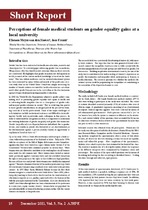| dc.contributor.author | Meyer-van den Heever, Ellenore | |
| dc.contributor.author | Frantz, Jose M. | |
| dc.date.accessioned | 2014-09-10T12:16:48Z | |
| dc.date.available | 2014-09-10T12:16:48Z | |
| dc.date.issued | 2011 | |
| dc.identifier.citation | Meyer-van den Heever, E. & Frantz, J.M. (2011). Perceptions of female medical students on gender equality gains at a local university. African Journal of Health Professions Education(AJHPE), 3(2): 15-16 | en_US |
| dc.identifier.issn | 2078-5127 | |
| dc.identifier.uri | http://hdl.handle.net/10566/1243 | |
| dc.description.abstract | Gender bias has been entrenched in healthcare education, research and clinical practice.1 In a review paper addressing gender bias in medicine, Wong stresses why this should receive attention when medical curricula are constructed. He highlights that gender inequities are still apparent in health, as much of the current medical knowledge is based on the ‘male norm’. This bias within healthcare and the medical educational system has been reiterated by many within and outside of the profession. A recent study done in the United States2 found that simply increasing the number of female students recruited for health education has not eliminated either gender bias present in the curriculum or the discrimination against women whilst participating in medical education. In 2002 the World Health Organization adopted a gender policy committing itself to promoting gender equality and equity in health and to redressing health inequities that are a consequence of gender roles and unequal gender-relations in society.3 Key to achieving this goal is to make gender considerations an integral part of the pre-service training curricula of health professionals. Some of the major challenges of such initiatives include institutional resistance and difficulties in involving key faculty and, in particular, male colleagues in this process. In order to understand the integration needed, it is important to understand the working definitions of gender inequality and gender discrimination. Gender inequality refers to disparity between individuals due to gender. Sexism, also known as gender discrimination or sex discrimination, is the discrimination against a person (usually female) in opportunity or employment based on their sex. Up to the early 1980s a South African woman could not open a bank account without the permission of her husband or father. Only in the 1990s with the acceptance of the Bill of Rights did women receive formal recognition that they were viewed as equal citizens under Section 9 of the Constitution.5 Previous laws condoned prejudice in various ways: White women were not allowed to contribute to the working force in all business areas under the old common law. Black women were viewed as minors under previously applied customary laws and that excluded them from the right to own property or the rights to their children as legal guardians. Because of their race and gender black women were doubly discriminated against.6 The male-dominated history of the medical profession kept South African women from pursuing a medical career until early in the previous century. In 1947 Mary Susan Malahele-Xakana became the first black woman to register as a medical doctor in South Africa.7 Since 1994, education policy-making in South Africa has focused on the transformation of education to improve access, quality, equity and redress for learners in line with the principles enshrined in the Constitution. A recent editorial in the SAMJ8 stated that although there has been a feminisation of the profession in recent years, equity remains elusive: women have not populated the specialisation fields or attained leadership positions in line with the current. The research field was a previously disadvantaged university, with mostly black students. The hope was that the data generated would reflect on and contrast the inequalities known to exist in wider society with the previous marginalisation of people-groups not only based on gender, but also on race. Building on previous international research, the aim of the study was to contribute to the understanding of women’s experiences on gender discrimination and inequality while participating as learners in health education. The research question was whether the medical educational system could be perpetuating the inequalities or contributing to the restoration of the disparities known to exist. | en_US |
| dc.language.iso | en | en_US |
| dc.publisher | Health and Medical Publishing Group | en_US |
| dc.rights | © 2011 Meyer-van den Heever & Frantz; licensee Health and Medical Publishing Group. This is an Open Access article distributed under the terms of the Creative Commons Attribution License (http://creativecommons.org/licenses/by/3.0), which permits unrestricted use, distribution, and reproduction in any medium, provided the original work is properly cited | |
| dc.subject | Gender bias | |
| dc.subject | Healthcare | |
| dc.subject | Gender discrimination | |
| dc.title | Perceptions of female medical students on gender equality gains at a local university | en_US |
| dc.type | Article | en_US |
| dc.privacy.showsubmitter | false | |
| dc.status.ispeerreviewed | true | |

